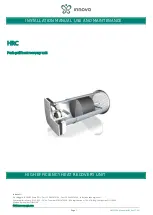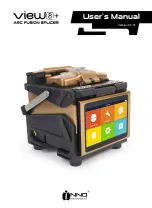
22
Alpha SolarSmart 150 - Component Replacement
8.6
CYLINDER TEMPERATURE SENSORS
Isolate the electrical supply before removing the casing. Remove the four plastic pins securing the top cover and remove
the cover. Remove the four plastic pins from the bottom cover to enable the centre cover to be unwrapped from the
insulation, the joint where the centre cover overlaps is stuck with double sided tape and will need to be peeled apart.
The sensors are located in two insulated pockets in the side of the insulation behind two polystyrene plugs. Carefully cut
the tape securing the plugs and remove them, peel the sensors from the cylinder and feed them out through the bottom
cover. Undo the two screws on the control box cover to expose the PCB and unplug the sensor leads from their plugs,
loosen the gland nut and remove the wires. Feed the new sensor leads through the gland and plug them into their
corresponding coloured sockets and tighten the gland. Feed the sensors up through the bottom casing and fit them to the
cylinder with using the tape supplied making sure they are in the correct location. Reassemble in reverse order.
8.7
PCB - refer to Section 9
Remove the screws securing the control cover and open the cover. Remove all terminal connections and remove all plug
in connections. Pull back the two clips to the left of the PCB and pull the PCB forwards to remove. Fit the new PCB and
reassemble in reverse order.
8.8
CYLINDER PUMP
Drain the cylinder as described in Section 8.2. Remove the terminal cover on the pump and remove the supply lead from the
terminals. Unscrew the four 5 mm Allen bolts and remove the pump head. Fit the new head and reassemble in reverse order.
8.9
CYLINDER MANIFOLD ASSEMBLY
Drain the cylinder as described in Section 8.2. Disconnect the power cable from the pump and the earth lead from the
manifold assembly and unplug the overheat thermostat. Disconnect all pipe connection and remove the two retaining
clips, one either side at the top of the manifold. It is now possible to pull down on the manifold and remove it from the
cylinder, taking care not to damage the plastic tubes connected to it.
With the manifold removed from the cylinder it is possible to replace or service the following parts; hot water outlet pipe,
mains inlet strainer/diffuser, hot inlet pipe, hot inlet diffuser and pump outlet pipe.
Re-assemble in reverse order.
8.10
DBU PUMP
Note: Care must be taken when carrying out repairs to the DBU as it reaches very high temperatures and can emit steam
from connections when being removed.
Isolate the electrical supply before removing the casing. Undo the two screws at the top and two screws at the bottom of
the casing and pull forwards to remove. Place a bucket under the expansion relief valve and using a 6mm Allen key
remove the bolt securing the valve and remove the valve. Using a spanner turn the square shaft located above the
expansion relief valve connection until water flows from the outlet and wait for it to stop (see fig 20). Using a 5mm Allen
key remove the four bolts securing the pump head and remove the pump, fit the new pump head and seal and refit the
bolts making sure not to over tighten them. Refer to Section 5.2 for refilling the DBU and reassemble in reverse order.
8.11
OVERHEAT THERMOSTAT
Isolate the electric supply. The overheat thermostat is located on a pipe at the bottom of the cylinder. Pull the plug from
the thermostat and unscrew the thermostat from the pipe.
Reassemble in reverse order.
8.12
OVERHEAT THERMOSTAT PLUG AND LEAD
Isolate the electric supply. Remove the screws securing the PCB cover and remove the cover. Unplug the thermostat
lead from terminal 12 on the PCB and the earth lead from its spade connection. Unplug the lead from the thermostat
located on the return pipe at the bottom of the cylinder. Loosen the gland securing the lead and remove the lead, then
feed the new lead into the gland and reassemble in reverse order.
8.13
COLLECTOR TEMPERATURE SENSOR
The collector sensor is sealed into the collector during manufacture. If it fails, a replacement sensor kit is available which
comprises of a sensor with a lead and grommet attached and a clip for securing the sensor to the collector plate. The
Collector will have a pre-drilled hole on one side blanked by a rubber grommet, which, must be removed to fit the new
sensor. The sensor should be fitted to the clip and then inserted through the hole in the collector with the sensor at the
back of the plate and the clip hooked over the front, similar to a pen clipped in a pocket. Slide the grommet along the lead
and into the hole making a seal.
Route the lead neatly to the break through in the roof and plug it into its connecting lead.
Note: 1) If a landscape collector is used the position of the grommet will be located at the top left hand side and for
portrait collectors the grommet will be located at the top right hand side.
2) Access to the grommet may be possible from within the roof area by removing tiles from inside.
For latest prices and delivery to your door visit MyTub Ltd - www.mytub.co.uk - info@mytub.co.uk 0844 556 1818







































